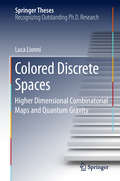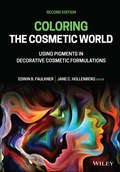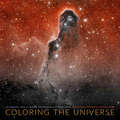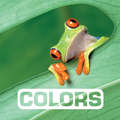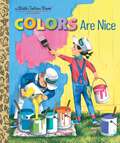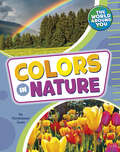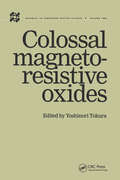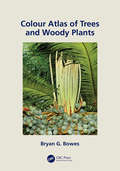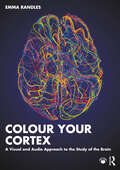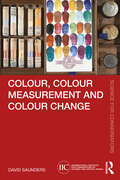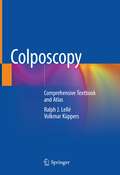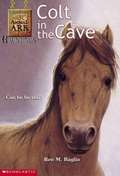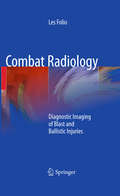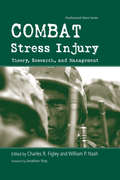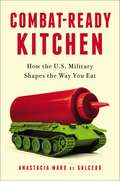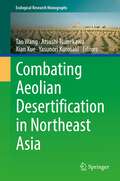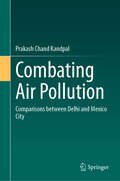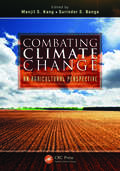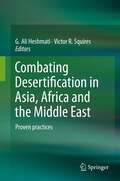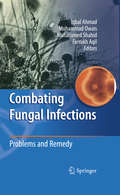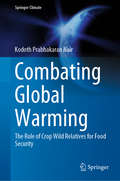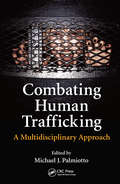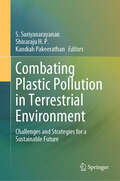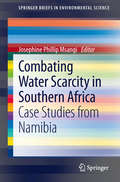- Table View
- List View
Colored Discrete Spaces: Higher Dimensional Combinatorial Maps and Quantum Gravity (Springer Theses)
by Luca LionniThis book provides a number of combinatorial tools that allow a systematic study of very general discrete spaces involved in the context of discrete quantum gravity. In any dimension D, we can discretize Euclidean gravity in the absence of matter over random discrete spaces obtained by gluing families of polytopes together in all possible ways. These spaces are then classified according to their curvature. In D=2, it results in a theory of random discrete spheres, which converge in the continuum limit towards the Brownian sphere, a random fractal space interpreted as a quantum random space-time. In this limit, the continuous Liouville theory of D=2 quantum gravity is recovered. Previous results in higher dimension regarded triangulations, converging towards a continuum random tree, or gluings of simple building blocks of small sizes, for which multi-trace matrix model results are recovered in any even dimension. In this book, the author develops a bijection with stacked two-dimensional discrete surfaces for the most general colored building blocks, and details how it can be used to classify colored discrete spaces according to their curvature. The way in which this combinatorial problem arrises in discrete quantum gravity and random tensor models is discussed in detail.
Coloring the Cosmetic World: Using Pigments in Decorative Cosmetic Formulations (Sdc-society Of Dyers And Colourists Ser.)
by Edwin B. FaulknerA comprehensive resource on the regulations, applications, properties and processing of pigments used in color cosmetics, now in its second edition. Coloring the Cosmetic World is a highly practical guide to colorant selection for product formulations in the modern cosmetics and toiletries industry. Providing the essential knowledge required to successfully incorporate pigments into cosmetic formulations, this unique resource covers all essential aspects of color selection—including regulations, economics, color esthetics, and stability—as well as processing, color measurement, pigment testing, natural colorants, and more. This new edition contains carefully revised content and includes updated coverage of economic and regulatory criteria. Drawing upon their decades of experience in the color industry, the author and editor focus on the specific color additives that are approved for use in cosmetics formulations. The book’s twelve in-depth chapters include full masstone representations of numerous pigments to help readers appreciate subtleties and differences in absorption pigments, effect pigments, specialty pigments, and others. Appendices contain various pigment test methods, a glossary, and an up-to-date listing of treated pigment patents. Covering the chemistry, regulations, evaluation, processing, and properties of worldwide cosmetic pigments, this one-of-a-kind book: Covers the common pigments used in lipsticks, face makeup, eye shadow, mascara, nail lacquer, and other color cosmetics Provides detailed information on a variety of specific pigments, including their chemical properties, esthetic quality, and application in a wide range of products Discusses regulatory considerations and the economics of selecting colors for use in different decorative cosmetics Highlights practical concerns such as colorants’ stability, interactions with other chemicals, manufacturing conditions, and packaging Explains how the effects of heat, light, pH, humidity, and other environmental factors inform pigment selection for different product types and use cases Coloring the Cosmetic World: Using Pigments in Decorative Cosmetic Formulations, Second Edition, is an indispensable guide for cosmetic chemists, a useful reference for purchasing agents, supply coordinators, and marketers working in the cosmetics industry, and a valuable supplementary
Coloring the Universe: An Insider's Look at Making Spectacular Images of Space
by Megan Watzke Kimberly Arcand Travis RectorWith a fleet of telescopes in space and giant observatories on the ground, professional astronomers produce hundreds of spectacular images of space every year. These colorful pictures have become infused into popular culture and can found everywhere, from advertising to television shows to memes. But they also invite questions: Is this what outer space really looks like? Are the colors real? And how do these images get from the stars to our screens? Coloring the Universe uses accessible language to describe how these giant telescopes work, what scientists learn with them, and how they are used to make color images. It talks about how otherwise un-seeable rays, such as radio waves, infrared light, X-rays, and gamma rays, are turned into recognizable colors. And it is filled with fantastic images taken in far-away pockets of the universe. Informative and beautiful, Coloring the Universe will give space fans of all levels an insider’s look at how scientists bring deep space into brilliant focus.
Colors (Picture This)
by Marie VendittelliColors are everywhere in nature. From a blue star fish to pink flamingos, children will find the many colors of the rainbow in these eye-catching photographs of animals in their natural habitats. Vibrant photography and simple, fun read-aloud text make this board book a perfect first look at nonfiction for very new and curious learners! The Picture This series pairs learning concepts with extraordinary photographs of animals in their habitats. Check out all four books in the Picture This series: Colors, Homes, Numbers, and Shapes!
Colors Are Nice (Little Golden Book)
by Adelaide HollA beloved 1962 Little Golden Book about colors (and not just primary ones) is back in print!"I like the way the sky is blue,And I like orange oranges, too.But I LOVE mixed-up colors best—A baby robin's speckled breast,Blackish dots on greenish frogs,Rainbow beetles under logs."This poetic look at colors, told in simple rhyme, celebrates not only primary colors, but "colors all mixed up!" Cheerful, elegant rhyme teaches about stripes, sparkles, and spots on adorable animals and in beautiful landscapes. Noted illustrator Leonard Shortall's lush illustrations of adorable animals and children will once again captivate little ones.
Colors in Nature (The World Around You)
by Christianne JonesFrom vibrant red flowers and clear blue skies to big brown trees and buzzing yellow bees, color is everywhere in nature. Interactive, rhyming text and bright photographs bring the bold colors of nature to young readers in this picture book.
Colossal Magnetoresistive Oxides (Advances in Condensed Matter Science)
by Yoshinori TokuraThe features and mechanism of Colossal Magnetoresistance, or CMR, in manganese oxides as well as device physics are highlighted in this book, with a focus on tunneling MR for some artificial structures. Underlying new science, such as tunable electron-lattice interaction in a metal and roles of orbital degrees of freedom in producing an unconventio
Colour Atlas of Woody Plants and Trees
by Bryan G. BowesTrees and plants are important components of the human environment having significant presence beyond agricultural and recreational values. Colour Atlas of Woody Plants and Trees presents a photographic compilation of morphological features of trees and shrubs giving attention to their unique aspects not presented in existing books. By increasing awareness to users through high quality, full-color photographs and informative text, this book demonstrates the enormous diversity of vascular trees and plants living today. Features: Full color atlas offers concise, but highly informative text accompanied by over 200 high-resolution digital tree images Contains images of the anatomy of tree structures and evolution of the most important features of trees Presents information on the varied structure and morphology exhibited by trees and demonstrates their vital importance in the current struggle for the survival of our human society Surveys the most important morphological features of plants, shrubs and trees Presents aspects of plants and trees both common and rarely seen in nature Bryan Geoffrey Bowes is a retired Senior Lecturer in the Botany Department at Glasgow University and was a Research Fellow in ETH Zurich, Harvard University, and University of New England, Australia. His research interests encompass plant anatomy and ultrastructure, plant regeneration, and morphogenesis in vitro.
Colour Your Cortex: A Visual and Audio Approach to the Study of the Brain
by Emma RandlesBring your learning to life through the mindful art of colouring. Offering an alternative style of learning, this insightful book combines easy-to-follow explanations of brain anatomy and functions with detailed, labelled diagrams to colour in. While colouring, you can sit back, relax, and listen to the accompanying online audio podcast, which clearly explains each topic. The unique interactive book covers a comprehensive list of brain anatomy, including how our brains grow, brain cells and how they communicate, important functions of the brain, brain disorders and reactions, and how our brains are protected. Using a conversational tone throughout, each chapter engages the reader with succinct descriptions of each topic, allowing them to easily digest and process the information, as they colour in the accompanying diagram. The book then concludes with a chapter on mindfulness and what benefits it can have for your brain and learning.Designed to simplify complex concepts into bite-sized, understandable chunks, this is the ideal resource for psychology, neuroscience, nursing, and medical students who prefer visual and audible methods of learning. This book is also for anyone interested in understanding more about brain anatomy and functions, but with a little fun, creativity, and relaxation along the way.
Colour, Colour Measurement and Colour Change (Science for Conservators)
by David SaundersColour, Colour Measurement and Colour Change, the first new book in the expanded Science for Conservators series, explains the science of colour, colour measurement and colour change for conservators in a clear and comprehensible way, elucidating the topic for those with no scientific background.The book explains how and why we see colours and how colour and colour change can be measured, as well as clarifying why these would be done in a conservation context. It then examines the ways in which colour can change – such as darkening, yellowing, fading, blanching and patination – illustrating these in different types of cultural heritage materials, including metals, varnishes, plastics, textiles and paints. The final chapter explores how colour change can be reduced in different types of storage and display settings, and, in particular, what can be done to protect against damage by light, damp and pollutants.This book is an invaluable introduction to all aspects of the science of colour in conservation. It is suitable for students in undergraduate and postgraduate conservation programmes, as well as being a useful reference guide for practising conservators.
Colours and Colour Vision
by Daniel KernellColours are increasingly important in our daily life but how did colour vision evolve? How have colours been made, used and talked about in different cultures and tasks? How do various species of animals see colours? Which physical stimuli allow us to see colours and by which physiological mechanisms are they perceived? How and why do people differ in their colour perceptions? In answering these questions and others, this book offers an unusually broad account of the complex phenomenon of colour and colour vision. The book's broad and accessible approach gives it wide appeal and it will serve as a useful coursebook for upper-level undergraduate students studying psychology, particularly cognitive neuroscience and visual perception courses, as well as for students studying colour vision as part of biology, medicine, art and architecture courses.
Colposcopy: Comprehensive Textbook and Atlas
by Ralph J. Lellé Volkmar KüppersThis comprehensive textbook and atlas provides detailed guidance on the performance and interpretation of colposcopy, with a particular focus on the diagnosis of precancerous cervical, vulvar, and vaginal lesions. The book not only describes the role of colposcopy in state of the art cervical cancer screening and triage but also covers the prevention, diagnosis, and management of cervical cancer in low-resource settings, where the vast majority of cases occur worldwide. The indications for colposcopy are clearly identified, and its use is described in a variety of specific circumstances, including during pregnancy, following surgical interventions and radiation treatment, and in the immunocompromised patient. The book will be of value for gynecologists and gynecologic oncologists, general practitioners, and family practice doctors; furthermore, physician assistants, nurses, and midwives will find it very useful for training and as a source of reference, regardless of whether they are working within an established screening program based on cytopathology and/or HPV testing or within a low-resource environment applying visual inspection as the primary screening strategy.
Colt in the Cave (Animal Ark Hauntings #4)
by Ben M. BaglioMandy and her best friend James are used to dealing with animals in distress. But ghostly animals in distress are a different matter... Mandy and James are excited about their school trip to an old mine. Deep underground, Mandy begins to imagine how difficult life must have been for the ponies that used to work down there. Suddenly, she spots eyes gleaming in the darkness, watching her. But James can't see a thing! The very next night, Mandy dreams about a troubled pony. What can it all mean -- is there a horse that needs her help?
Combat Radiology: Diagnostic Imaging of Blast and Ballistic Injuries
by Les R. FolioCombat Radiology provides unique insights into a military radiologist's role in the modern battlefield environment. Drawing on his recent experiences in Iraq, Col. Les Folio, a retired air force radiologist and flight surgeon with over twenty years of service, presents a comprehensive introduction to diagnostic imaging technology for the deployed military physician. Topics in the book include descriptions of imaging capabilities of hospitals in deployed military bases in combat zones; practical imaging techniques and terminology associated with penetrating/perforating blast and ballistic injuries; recent medical advances on the battlefield; and the changing role of imaging modalities in combat situations. Additionally, specific anatomic and pathologic imaging cases from combat situations are presented, including traumatic brain injury, chest, abdomen/pelvis, and skeletal trauma. Combat Radiology will appeal not only to military radiologists and surgeons, but also to civilian emergency radiologists and trauma physicians who encounter patients with ballistic and blast injuries resulting from armed conflict, terrorism, and disaster situations.
Combat Stress Injury: Theory, Research, and Management (Psychosocial Stress Series)
by William P. Nash Charles R. FigleyCombat Stress Injury represents a definitive collection of the most current theory, research, and practice in the area of combat and operational stress management, edited by two experts in the field. In this book, Charles Figley and Bill Nash have assembled a wide-ranging group of authors (military / nonmilitary, American / international, combat veterans / trainers, and as diverse as psychiatrists / psychologists / social workers / nurses / clergy / physiologists / military scientists). The chapters in this volume collectively demonstrate that combat stress can effectively be managed through prevention and training prior to combat, stress reduction methods during operations, and desensitization programs immediately following combat exposure.
Combat-Ready Kitchen
by Anastacia Marx de SalcedoAmericans eat more processed foods than anyone else in the world. We also spend more on military research. These two seemingly unrelated facts are inextricably linked. If you ever wondered how ready-to-eat foods infiltrated your kitchen, you'll love this entertaining romp through the secret military history of practically everything you buy at the supermarket.In a nondescript Boston suburb, in a handful of low buildings buffered by trees and a lake, a group of men and women spend their days researching, testing, tasting, and producing the foods that form the bedrock of the American diet. If you stumbled into the facility, you might think the technicians dressed in lab coats and the shiny kitchen equipment belonged to one of the giant food conglomerates responsible for your favorite brand of frozen pizza or microwavable breakfast burritos. So you'd be surprised to learn that you've just entered the U.S. Army Natick Soldier Systems Center, ground zero for the processed food industry.Ever since Napoleon, armies have sought better ways to preserve, store, and transport food for battle. As part of this quest, although most people don't realize it, the U.S. military spearheaded the invention of energy bars, restructured meat, extended-life bread, instant coffee, and much more. But there's been an insidious mission creep: because the military enlisted industry--huge corporations such as ADM, ConAgra, General Mills, Hershey, Hormel, Mars, Nabisco, Reynolds, Smithfield, Swift, Tyson, and Unilever--to help develop and manufacture food for soldiers on the front line, over the years combat rations, or the key technologies used in engineering them, have ended up dominating grocery store shelves and refrigerator cases. TV dinners, the cheese powder in snack foods, cling wrap . . . The list is almost endless.Now food writer Anastacia Marx de Salcedo scrutinizes the world of processed food and its long relationship with the military--unveiling the twists, turns, successes, failures, and products that have found their way from the armed forces' and contractors' laboratories into our kitchens. In developing these rations, the army was looking for some of the very same qualities as we do in our hectic, fast-paced twenty-first-century lives: portability, ease of preparation, extended shelf life at room temperature, affordability, and appeal to even the least adventurous eaters. In other words, the military has us chowing down like special ops.What is the effect of such a diet, eaten--as it is by soldiers and most consumers--day in and day out, year after year? We don't really know. We're the guinea pigs in a giant public health experiment, one in which science and technology, at the beck and call of the military, have taken over our kitchens.From the Hardcover edition.
Combating Aeolian Desertification in Northeast Asia (Ecological Research Monographs)
by Tao Wang Atsushi Tsunekawa Xian Xue Yasunori KurosakiThis book presents the definition of aeolian desertification and uncovers its processes, driving factors, and consequences, and focuses on measures to effectively combat aeolian desertification in Northeast Asia. Aeolian desertification in Northeast Asia is of great concern for its destructive influences on the environment and society not only in the local but also in faraway areas. The topics of this book are addressed by compiling theoretical review, remote sensing monitoring, synoptic analysis, and laboratory and field studies in China, Japan, and Mongolia. This is the first comprehensive book to address the aeolian desertification in Northeast Asia. Readers can learn the basic theory of aeolian desertification and the primary causes of this environmental problem. More critical is the successful practical countermeasures to combat desertification which can be referred to by various stakeholders who concern the aeolian desertification in Northeast Asia. To meet the Sustainable Development Goals of the United Nations adopted in 2015, especially its Goal 15.3 to achieve a land degradation-neutral world by 2030, desertification combating actions should be taken cross country borders. This book is not only intended for environmental professionals but also for people who are affected and concerned about desertification and land degradation. The concept and processes in this book will serve as a ready reference to understand the aeolian desertification with countermeasures and successful preventing stories that can be referred to.
Combating Air Pollution: Comparisons between Delhi and Mexico City
by Prakash Chand KandpalThe primary objective of this book is to probe into the menace of air pollution in Delhi, which has emerged as the main threat to public health and the environment in the capital city. The book explores the viable solutions to the problem, examines the existing policies and programmes developed by the Government and the policy makers to address the issue, traverse the hurdles in the implementation of these policies and reveals the politics over air pollution in Delhi. It also discusses about the other highly polluted cities of the world, specifically Mexico City, which has faced environmental emergencies due to air pollution in the past, and how these cities have prepared themselves to combat the menace of air pollution, and what can be learnt from their experiences to face the same situations in Delhi. The book examines how air pollution is being addressed in the context of environmental policy frameworks and politics, and will be of use to policy makers, researchers, governmental and non-governmental agencies working to combat air pollution in major cities.
Combating Climate Change: An Agricultural Perspective
by Manjit S. Kang Surinder S. BangaThe effects of climate change can already be felt around the world, and they will likely impact all facets of human civilization-from health, livelihood security, agricultural production, and shelter to international trade. Since anthropogenic factors are mainly to blame for the current trends in global warming, human intervention will be necessary
Combating Desertification in Asia, Africa and the Middle East: Proven practices
by Victor R. Squires G. Ali HeshmatiThis book is about the 'how' of desertification control as opposed to an analysis of the 'why' and fills a gap in the desertification-related literature in that it shows what to do in situations ranging from fixing mobile sands to arresting accelerated soil erosion in sloping lands. There are numerous illustrations to show the successful techniques. This compilation demonstrates that desertification and land degradation can be controlled and reversed with existing techniques in such widely varying environments as the Sahel of Africa to Sri Lanka and the Philippines in SE Asia, from mountains in Lesotho to low lands on desert margins in Mongolia. Proven approaches include technical interventions, changes in governance and to the legislative framework and policy reform. The book fills a gap in the desertification-related literature in that it shows what to do in situations ranging from fixing mobile sands to arresting accelerated soil erosion in sloping lands.
Combating Fungal Infections: Problems and Remedy
by Iqbal Ahmad Mohammed Shahid Farrukh Aqil Mohammad OwaisThe currently available means of combating fungal infections are weak and clumsy. The application of fungal genomics offers an unparalleled opportunity to develop novel antifungal drugs. Interestingly, several novel antifungal drug targets have already been identified and validated. However, it is premature to expect a novel antifungal agent in clinical setting as drug discovery programs are still in their infancy. In addition to classical and genomic approaches to drug discovery, treasure trove based on natural products and phytomedicine can provide a multitude of alternative modes of combating fungal infection. This book incisively addresses essential topics on various aspects pertaining to fungal diseases in human and animals, their reservoir, fungal pathogenesis, their management and recent advances in their treatment. Issues of antifungal drug toxicity, especially nephrotoxicity, are also discussed. The development of resistance in fungal pathogens, including multidrug resistance and its mechanism, is dealt with in two chapters. Diverse diagnostic approaches to fungal infections are also reviewed. The combinational drug strategies used in combating invasive fungal infections are addressed in detail. The management of pulmonary mycoses in stem cell transplantation is also given special focus. Novel antifungal drugs (synthetic and herbal), fungal vaccines, and metabolic pathways as drug targets are discussed in detail in three different chapters. Subsequently the roles of innate immunity, cytokine therapy and immunomodulators in the treatment of fungal infections are elaborated upon. As novel drug delivery systems have a great potential for modifying the pharmacokinetics of medications, the last chapter takes this fact into consideration in its examination of state-of-the-art delivery systems in controlling fungal infections.
Combating Global Warming: The Role of Crop Wild Relatives for Food Security (Springer Climate)
by Kodoth Prabhakaran NairThis book critically examines the environmental hazards posed by global warming with regard to future food security, which will depend on a combination of stresses, both biotic and abiotic, imposed by climate change; variability of weather within a growing season; and the development of cultivars that are more sensitive to different ambient conditions. Furthermore, the ability to develop effective adaptive strategies which allow these cultivars to express their genetic potential under changing climate conditions will be essential. In turn, the book investigates those plant species which are very closely related to field crops and have the potential to contribute beneficial traits for crop improvement, e.g. resistance to a wide range of biotic and abiotic stresses, enriching the gene pool, and ultimately leading to enhanced plant yield, known as “Crop Wild Relatives” (CWRs). CWRs hold tremendous potential to sustain and enhance global food security, contributing to human well-being. Accordingly, their development, characterization and conservation in crop breeding programs have assumed great practical importance.Professor Kodoth Prabhakaran Nair is an internationally acclaimed agricultural scientist, with over three decades of experience in Europe, Africa and Asia, holding some of the most prestigious academic positions, including the National Chair of the Science Foundation, The Royal Society, Belgium. A Senior Fellow of the world renowned Alexander von Humboldt Research Foundation of The Federal Republic of Germany, he is best known, globally, for having developed a revolutionary soil management technique, known as "The Nutrient Buffer Power Concept", which, while questioning the scientific fallacies of the highly soil extractive farming, euphemistically known as the "green revolution", has opened up an alternative path for sensible and scientific soil management
Combating Human Trafficking: A Multidisciplinary Approach
by Michael J. PalmiottoApproaching the topic from a law enforcement perspective, this volume provides an unprecedented look at the investigation of human trafficking in America. Beginning with historical, sociological, and psychological perspectives, the book discusses how authorities can best conduct an investigation of trafficking. It reviews federal agencies responsible for confronting the problem, examines relevant laws and legal trends, and discusses law enforcement awareness and training. An ideal resource for police investigators, police training, and community outreach organizations, the book is also suitable as a college text for criminal justice courses.
Combating Plastic Pollution in Terrestrial Environment: Challenges and Strategies for a Sustainable Future
by Kandiah Pakeerathan S. Suriyanarayanan Shivaraju H. P.This book explores the challenges posed by plastic pollution in terrestrial environment and focuses on the reuse of plastic waste for sustainable practices, as well as the challenges and innovative approaches to combat the growing plastic crisis. This book is intended for a diverse audience including researchers, policymakers, environmental professionals, educators, technocrats, and researchers/students interested in advancing knowledge and action on plastic pollution in terrestrial environment. 27 chapters included in the book are contributed by scientists, researchers and policymakers from 12 countries, namely Bangladesh, Egypt, India, Iraq, Malaysia, Mauritius, Mexico, Myanmar, Nepal, Pakistan, Sri Lanka, and Taiwan.
Combating Water Scarcity in Southern Africa: Case Studies from Namibia (SpringerBriefs in Environmental Science)
by Josephine Phillip MsangiThis book offers a close examination of water scarcity as a developmental challenge facing member nations of the Southern African Development Community (SADC), the interventions that have been implemented to combat the situation and the challenges still outstanding. The first chapter paints the backdrop of the water scarcity problem, reviewing historical approaches from the 1992 Earth Summit in Rio de Janeiro to the Johannesburg World Summit on Sustainable Development (2002) to the United Nations Rio+20 Conference on Sustainable Development (2012), and recapping principles and agreements reached during and after these conferences. Chapter two examines the Southern Africa region's efforts to combat water scarcity including principles, policies and strategies and the responsibility of each member to implement them. Written by the editor, J.P. Msangi, the chapter describes Namibia's efforts to ensure management of scarce water. Beyond enacting management and pollution control regulations and raising public awareness, Namibia encourages research to ensure attainment of the requirements of both the SADC Protocol and its own water scarcity management laws. The next three chapters offer Namibia-based case studies on impacts of pollution on water treatment; on the effects of anthropogenic activities on water quality and on the effects of water transfers from dams upstream of Von Bach dam. The final chapter provides detailed summaries of the issues discussed in the book, highlighting conclusions and offering recommendations. Combating Water Scarcity in Southern Africa synthesizes issues pertinent to the SADC countries as well as to other regions, and offers research that up to now has not been conducted in Namibia.
